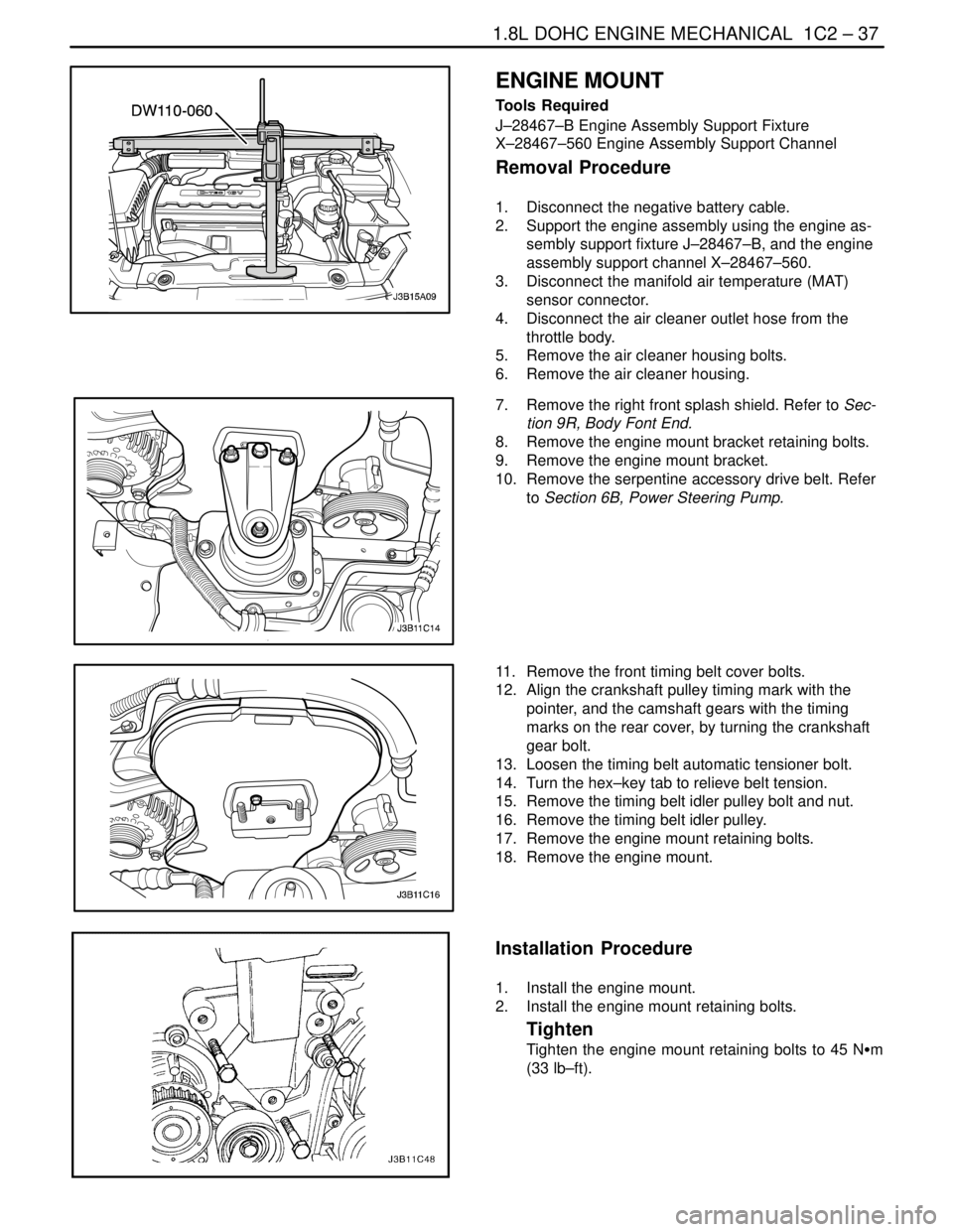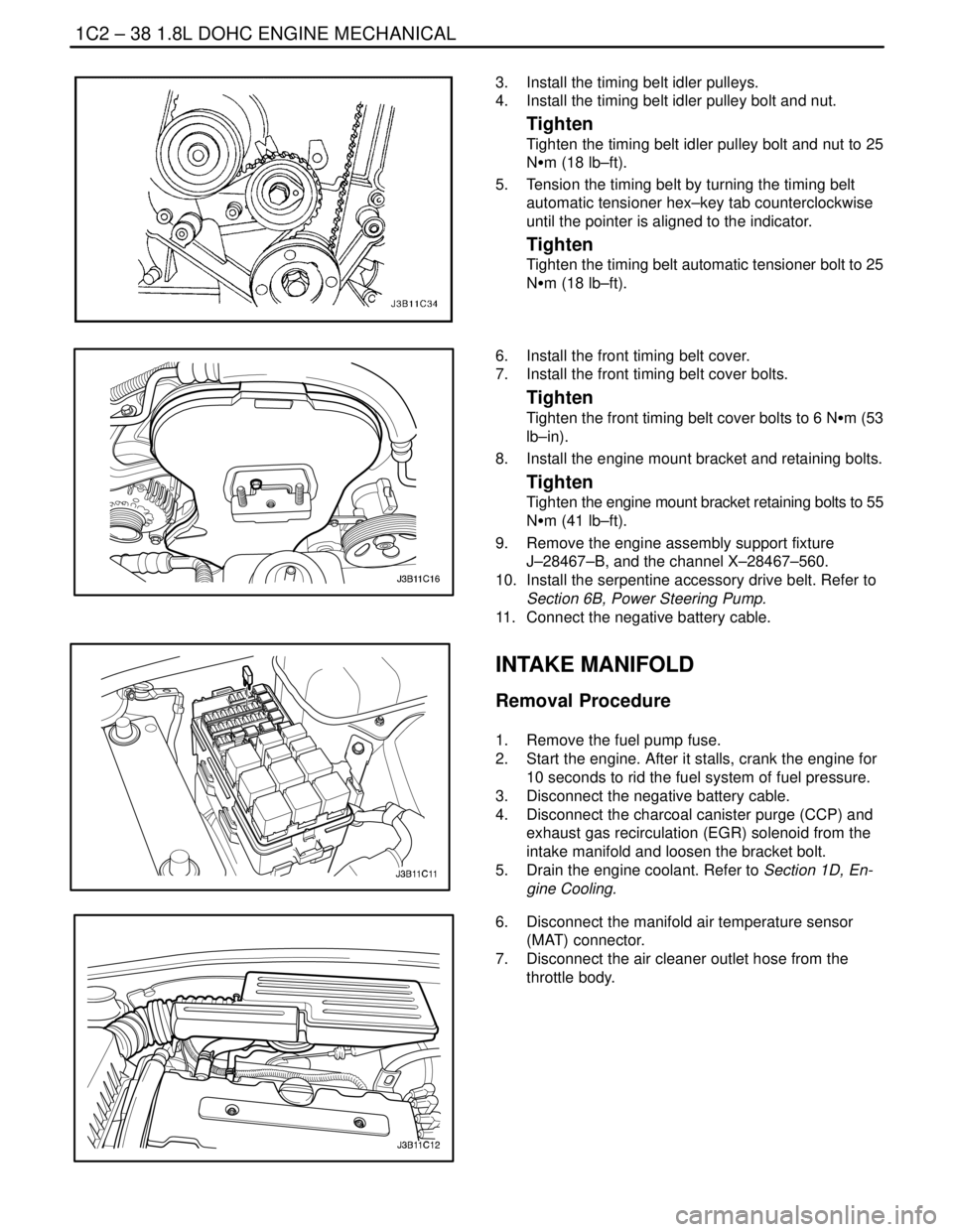key battery DAEWOO NUBIRA 2004 Service Repair Manual
[x] Cancel search | Manufacturer: DAEWOO, Model Year: 2004, Model line: NUBIRA, Model: DAEWOO NUBIRA 2004Pages: 2643, PDF Size: 80.54 MB
Page 157 of 2643

1.8L DOHC ENGINE MECHANICAL 1C2 – 37
DAEWOO V–121 BL4
ENGINE MOUNT
Tools Required
J–28467–B Engine Assembly Support Fixture
X–28467–560 Engine Assembly Support Channel
Removal Procedure
1. Disconnect the negative battery cable.
2. Support the engine assembly using the engine as-
sembly support fixture J–28467–B, and the engine
assembly support channel X–28467–560.
3. Disconnect the manifold air temperature (MAT)
sensor connector.
4. Disconnect the air cleaner outlet hose from the
throttle body.
5. Remove the air cleaner housing bolts.
6. Remove the air cleaner housing.
7. Remove the right front splash shield. Refer to Sec-
tion 9R, Body Font End.
8. Remove the engine mount bracket retaining bolts.
9. Remove the engine mount bracket.
10. Remove the serpentine accessory drive belt. Refer
to Section 6B, Power Steering Pump.
11. Remove the front timing belt cover bolts.
12. Align the crankshaft pulley timing mark with the
pointer, and the camshaft gears with the timing
marks on the rear cover, by turning the crankshaft
gear bolt.
13. Loosen the timing belt automatic tensioner bolt.
14. Turn the hex–key tab to relieve belt tension.
15. Remove the timing belt idler pulley bolt and nut.
16. Remove the timing belt idler pulley.
17. Remove the engine mount retaining bolts.
18. Remove the engine mount.
Installation Procedure
1. Install the engine mount.
2. Install the engine mount retaining bolts.
Tighten
Tighten the engine mount retaining bolts to 45 NSm
(33 lb–ft).
Page 158 of 2643

1C2 – 38I1.8L DOHC ENGINE MECHANICAL
DAEWOO V–121 BL4
3. Install the timing belt idler pulleys.
4. Install the timing belt idler pulley bolt and nut.
Tighten
Tighten the timing belt idler pulley bolt and nut to 25
NSm (18 lb–ft).
5. Tension the timing belt by turning the timing belt
automatic tensioner hex–key tab counterclockwise
until the pointer is aligned to the indicator.
Tighten
Tighten the timing belt automatic tensioner bolt to 25
NSm (18 lb–ft).
6. Install the front timing belt cover.
7. Install the front timing belt cover bolts.
Tighten
Tighten the front timing belt cover bolts to 6 NSm (53
lb–in).
8. Install the engine mount bracket and retaining bolts.
Tighten
Tighten the engine mount bracket retaining bolts to 55
NSm (41 lb–ft).
9. Remove the engine assembly support fixture
J–28467–B, and the channel X–28467–560.
10. Install the serpentine accessory drive belt. Refer to
Section 6B, Power Steering Pump.
11. Connect the negative battery cable.
INTAKE MANIFOLD
Removal Procedure
1. Remove the fuel pump fuse.
2. Start the engine. After it stalls, crank the engine for
10 seconds to rid the fuel system of fuel pressure.
3. Disconnect the negative battery cable.
4. Disconnect the charcoal canister purge (CCP) and
exhaust gas recirculation (EGR) solenoid from the
intake manifold and loosen the bracket bolt.
5. Drain the engine coolant. Refer to Section 1D, En-
gine Cooling.
6. Disconnect the manifold air temperature sensor
(MAT) connector.
7. Disconnect the air cleaner outlet hose from the
throttle body.
Page 223 of 2643

ENGINE ELECTRICAL 1E – 9
DAEWOO V–121 BL4
STARTER MOTOR NOISE
To correct starter motor noise during starting, use the following procedure:
Checks
Action
Check for a high–pitched whine during cranking, before
the engine fires. The engine cranks and fires properly.The distance is too great between the starter pinion and
the flywheel. Shimming the starter toward the flywheel is
required.
Check for a high–pitched whine after the engine fires, as
the key is being released. The engine cranks and fires
properly. This intermittent complaint is often diagnosed as
”starter hang–in” or ”solenoid weak.”The distance is too small between the starter pinion and
the flywheel. Shimming the starter away from the flywheel
is required.
Check for a loud ”whoop” after the engine fires but while
the starter is still held engaged. The sound is like a siren
if the engine is revved while the starter is engaged.The most probable cause is a defective clutch. A new
clutch will often correct this problem.
Check for a ”rumble,” a ”growl,” or, in severe cases, a
”knock” as the starter is coasting down to a stop after start-
ing the engine.The most probable cause is a bent or unbalanced starter
armature. A new armature will often correct this problem.
If the complaint is noise, correction can be achieved by
proper shimming as follows:
1. Check for a bent or a worn flywheel.
2. Start the engine and carefully touch the outside di-
ameter of the rotating flywheel ring gear with chalk
or a crayon to show the high point of the tooth run-
out. Turn the engine OFF and rotate the flywheel so
that the marked teeth are in the area of the starter
pinion gear.
3. Disconnect the negative battery cable to prevent
cranking the engine.
4. Check the pinion–to–flywheel clearance by using a
wire gauge of 0.5 mm (0.02 inch) minimum thick-
ness (or diameter). Center a pinion tooth between
two flywheel teeth and the gauge. Do not gauge in
the corners, where a misleading larger dimension
may be observed. If the clearance is under this
minimum, shimming the starter away from the fly-
wheel is required.
5. If the clearance approaches 1.5 mm (0.06 inch) or
more, shimming the starter toward the flywheel is
required. This condition is generally the cause of
broken flywheel teeth or the starter housing. Shim
the starter toward the flywheel by shimming only
the outboard starter mounting pad. A shim of 0.40
mm (0.016 inch) thickness at this location will de-
crease the clearance by approximately 0.30 mm
(0.012 inch). If normal starter shims are not avail-
able, plain washers or other suitable material may
be used as shims.BATTERY LOAD TEST
1. Check the battery for obvious damage, such as a
cracked or broken case or cover, which could per-
mit the loss of electrolyte. If obvious damage is
noted, replace the battery.
CAUTION : Do not charge the battery if the hydrome-
ter is clear or light yellow. Instead, replace the battery.
If the battery feels hot, or if violent gassing or spew-
ing of electrolyte through the vent hole occurs, dis-
continue charging or reduce the charging rate to
avoid personal injury.
2. Check the hydrometer. If the green dot is visible, go
to the load test procedure. If the indicator is dark
but green is not visible, charge the battery. For
charging a battery removed from the vehicle, refer
to ”Charging a Completely Discharged Battery” in
this section.
3. Connect a voltmeter and a battery load tester
across the battery terminals.
4. Apply a 300–ampere load for 15 seconds to remove
any surface charge from the battery.
5. Remove the load.
6. Wait 15 seconds to let the battery recover, and ap-
ply a 270–ampere load.
Important : The battery temperature must be estimated
by touch and by the temperature condition the battery has
been exposed for the preceding few hours.
7. If the voltage does not drop below the minimum
listed, the battery is good and should be reinstalled.
If the voltage is less than the minimum listed, re-
place the battery. Refer to ”Battery Specifications”
in this section.
Page 352 of 2643

1F – 106IENGINE CONTROLS
DAEWOO V–121 BL4
DATA LINK CONNECTOR DIAGNOSIS (1.4L/1.6L DOHC)
Circuit Description
The provision for communicating with the Engine Control
Module (ECM) is the Data Link Connector (DLC). It is lo-
cated under the instrument panel. The DLC is used to con-
nect the scan tool. Battery power and ground is supplied
for the scan tool through the DLC. The Keyword 2000 seri-
al data circuit to the DLC allows the ECM to communicate
with the scan tool. A Universal Asynchronous Receiver
Transmitter (UART) serial data line is used to communi-
cate with the other modules such as the Electronic Brake
Control Module (EBCM), the Supplemental Inflatable Re-
straint (SIR) system. and the Instrument Panel Cluster.
Diagnostic Aids
Ensure that the correct application (model line, car year,
etc.) has been selected on the scan tool. If communication
still cannot be established, try the scan tool on another ve-
hicle to ensure that the scan tool or cables are not the
cause of the condition.
An intermittent may be caused by a poor connection,
rubbed through wire insulation, or a broken wire inside the
insulation.
Any circuitry that is suspected of causing an intermittent
complaint should be thoroughly checked for the following
conditions:
S Backed–out terminals.S Improper mating of terminals.
S Broken locks.
S Improperly formed or damaged terminals.
S Poor terminal–to–wiring connection.
S Physical damage to the wiring harness.
S Corrosion.
Test Description
Number(s) below refer to the step number(s) on the Diag-
nostic Table.
1. The On–Board Diagnostic (EOBD) System Check
prompts the technician to complete some basic
checks and store the freeze frame and failure re-
cords data on the scan tool if applicable. This
creates an electronic copy of the data taken when
the malfunction occurred. The information is then
stored on the scan tool for later reference.
2. Unlike the UART serial data circuit, the only time a
Class II serial data circuit has any voltage on it is
when a scan tool asks the ECM for information and
sends the information out.
5. Locate and repair any shorts that may have caused
the fuse to open before replacement, if the no volt-
age condition was due to an open fuse.
10. The scan tool or associated cables could be mal-
functioning. Refer to the scan tool’s manual for re-
pair information.
Page 354 of 2643

1F – 108IENGINE CONTROLS
DAEWOO V–121 BL4
DATA LINK CONNECTOR DIAGNOSIS (1.8L DOHC)
Circuit Description
The provision for communicating with the Engine Control
Module (ECM) is the Data Link Connector (DLC). It is lo-
cated under the instrument panel. The DLC is used to con-
nect the scan tool. Battery power and ground is supplied
for the scan tool through the DLC. The Keyword 2000 seri-
al data circuit to the DLC allows the ECM to communicate
with the scan tool. A Universal Asynchronous Receiver
Transmitter (UART) serial data line is used to communi-
cate with the other modules such as the Electronic Brake
Control Module (EBCM), the Supplemental Inflatable Re-
straint (SIR) system. and the Instrument Panel Cluster.
Diagnostic Aids
Ensure that the correct application (model line, car year,
etc.) has been selected on the scan tool. If communication
still cannot be established, try the scan tool on another ve-
hicle to ensure that the scan tool or cables are not the
cause of the condition.
An intermittent may be caused by a poor connection,
rubbed through wire insulation, or a broken wire inside the
insulation.
Any circuitry that is suspected of causing an intermittent
complaint should be thoroughly checked for the following
conditions:
S Backed–out terminals.S Improper mating of terminals.
S Broken locks.
S Improperly formed or damaged terminals.
S Poor terminal–to–wiring connection.
S Physical damage to the wiring harness.
S Corrosion.
Test Description
Number(s) below refer to the step number(s) on the Diag-
nostic Table.
1. The On–Board Diagnostic (EOBD) System Check
prompts the technician to complete some basic
checks and store the freeze frame and failure re-
cords data on the scan tool if applicable. This
creates an electronic copy of the data taken when
the malfunction occurred. The information is then
stored on the scan tool for later reference.
2. Unlike the UART serial data circuit, the only time a
Class II serial data circuit has any voltage on it is
when a scan tool asks the ECM for information and
sends the information out.
5. Locate and repair any shorts that may have caused
the fuse to open before replacement, if the no volt-
age condition was due to an open fuse.
10. The scan tool or associated cables could be mal-
functioning. Refer to the scan tool’s manual for re-
pair information.
Page 357 of 2643

ENGINE CONTROLS 1F – 111
DAEWOO V–121 BL4
TROUBLE CODE DIAGNOSIS
(1.4L/1.6L DOHC)
CLEARING TROUBLE CODES
Notice : To prevent Engine Control Module (ECM) dam-
age, the key must be OFF when disconnecting or recon-
necting the power to the ECM (for example battery cable,
ECM pigtail connector, ECM fuse, jumper cables,
etc.).When the ECM sets a Diagnostic Trouble Code
(DTC), the Malfunction Indicator Lamp (MIL) lamp will be
turned on only for type A, B and E but a DTC will be stored
in the ECM’s memory for all types of DTC. If the problemis intermittent, the MIL will go out after 10 seconds if the
fault is no longer present. The DTC will stay in the ECM’s
memory until cleared by scan tool. Removing battery volt-
age for 10 seconds will clear some stored DTCs.
DTCs should be cleared after repairs have been com-
pleted. Some diagnostic tables will tell you to clear the
codes before using the chart. This allows the ECM to set
the DTC while going through the chart, which will help to
find the cause of the problem more quickly.
DIAGNOSTIC TROUBLE CODES (1.4L/1.6L DOHC)
DTCFunctionError
TypeIlluminate MIL
P0107Manifold Absolute Pressure Sensor Low VoltageAYES
P0108Manifold Absolute Pressure Sensor High VoltageAYES
P0112Intake Air Temperature Sensor Low VoltageEYES
P0113Intake Air Temperature Sensor High VoltageEYES
P0117Engine Coolant Temperature Sensor Low VoltageAYES
P0118Engine Coolant Temperature Sensor High VoltageAYES
P0122Throttle Position Sensor Low VoltageAYES
P0123Throttle Position Sensor High VoltageAYES
P0131Front Heated Oxygen Sensor Low VoltageAYES
P0132Front Heated Oxygen Sensor High VoltageAYES
P0133Front Heated Oxygen Sensor No ActivityEYES
P0135Front Heated Oxygen Sensor Heater Circuit Not FunctioningEYES
P0137Rear Heated Oxygen Sensor Low VoltageEYES
P0138Rear Heated Oxygen Sensor High VoltageEYES
P0140Rear Heated Oxygen Sensor No ActivityEYES
P0141Rear Heated Oxygen Sensor Heater MalfuctionEYES
P0171Fuel Trim System Too LeanEYES
P0172Fuel Trim System Too RichEYES
P0222Main Throttle Idle Actuactor (MTIA) Low VoltageAYES
P0223Main Throttle Idle Actuactor (MTIA) High VoltageAYES
P0261Injector 1 Low VoltageAYES
P0262Injector 1 High VoltageAYES
P0264Injector 2 Low VoltageAYES
P0265Injector 2 High VoltageAYES
P0267Injector 3 Low VoltageAYES
P0268Injector 3 High VoltageAYES
P0270Injector 4 Low VoltageAYES
P0271Injector 4 High VoltageAYES
P0300Multiple Cylinder Misfire (Catalyst Damage)ABLINKING
Page 360 of 2643

1F – 114IENGINE CONTROLS
DAEWOO V–121 BL4
DIAGNOSTIC TROUBLE CODE (DTC) P0107
MANIFOLD ABSOLUTE PRESSURE SENSOR LOW
VOLTAGE
Circuit Description
The engine control module (ECM) uses the Manifold Ab-
solute Pressure (MAP) sensor to control the fuel delivery
and the ignition timing. The MAP sensor measures the
changes in the intake manifold pressure, which results
from engine load (intake manifold vacuum) and the rpm
changes; and converts these into voltage outputs. The
ECM sends a 5 volt–reference voltage to the MAP sensor.
As the manifold pressure changes, the output voltage of
the MAP sensor also changes. By monitoring the MAP
sensor output voltage, the ECM knows the manifold pres-
sure. A low–pressure (low voltage) output voltage will be
about 1.0 to 1.5 volts at idle, while higher pressure (high
voltage) output voltage will be about 4.5 to 4.8 at wide
open throttle (WOT). The MAP sensor is metric pressure,
allowing the ECM to make adjustments for different alti-
tudes.
Conditions for Setting the DTC
S This DTC can be stored in ”key–on” status.
(Case A)
S When the engine idling.
S No throttle position(TP) sensor MTIA fail conditions
present.
S Engine speed(rpm) is less than 2,500rpm.
S The MAP is less than 12.0 kPa.
(Case A)
S When the engine part load.
S The engine revolution speed is less than 4,000rpm.S No Throttle Position (TP) Sensor fails conditions
present.
S The Throttle Position (TP) angle greather than
30.0°.
S The MAP is less than 11.5 kPa.
S An open or low voltage condition exists.
Action Taken When the DTC Sets
S The Malfunction Indicator Lamp (MIL) will illumi-
nate.
S The ECM will record operating conditions at the
time the diagnostic fails. This information will be
stored in the Freeze Frame and Failure Records
buffers.
S A history DTC is stored.
S The coolant fan turns ON.
S The ECM will substitutes a fixed MAP value and
use TP to control the fuel delivery (the scan tool will
not show defaulted)
Conditions for Clearing the MIL/DTC
S The MIL will turn off after four consecutive ignition
cycles in which the diagnostic runs without a fault.
S A history DTC will clear after 40 consecutive warm–
up cycles without a fault.
S DTC(s) can be cleared by using the scan tool.
S Disconnecting the ECM battery feed for more than
10 seconds.
Diagnostic Aids
With the ignition ON and the engine stopped, the manifold
pressure is equal to atmosphere pressure and the signal
voltage will be high.
Page 363 of 2643

ENGINE CONTROLS 1F – 117
DAEWOO V–121 BL4
DIAGNOSTIC TROUBLE CODE (DTC) P0108
MANIFOLD ABSOLUTE PRESSURE SENSOR HIGH
VOLTAGE
Circuit Description
The engine control module (ECM) uses the Manifold Ab-
solute Pressure (MAP) sensor to control the fuel delivery
and the ignition timing. The MAP sensor measures the
changes in the intake manifold pressure, which results
from engine load (intake manifold vacuum) and the rpm
changes; and converts these into voltage outputs. The
ECM sends a 5 volt–reference voltage to the MAP sensor.
As the manifold pressure changes, the output voltage of
the MAP sensor also changes. By monitoring the MAP
sensor output voltage, the ECM knows the manifold pres-
sure. A low–pressure (low voltage) output voltage will be
about 1.0 to 1.5 volts at idle, while higher pressure (high
voltage) output voltage will be about 4.5 to 4.8 at wide
open throttle (WOT). The MAP sensor is metric pressure,
allowing the ECM to make adjustments for different alti-
tudes.
Conditions for Setting the DTC
S This DTC can be stored in ”key–on” status.
S When the engine idling.
S Engine speed is greater than 700rpm.
S No throttle position sensor (TPS) fail conditions
present.
S The MAP is greater than 95kPA.
S A high voltage condition exists.
Action Taken When the DTC Sets
S The Malfunction Indicator Lamp (MIL) will illumi-
nate.
S The ECM will record operating conditions at the
time the diagnostic fails. This information will be
stored in the Freeze Frame and Failure Records
buffers.S A history DTC is stored.
S The ECM will substitutes a fixed MAP value and
use TP to control the fuel delivery (the scan tool will
not show defaulted)
Conditions for Clearing the MIL/DTC
S The MIL will turn off after four consecutive ignition
cycles in which the diagnostic runs without a fault.
S A history DTC will clear after 40 consecutive warm–
up cycles without a fault.
S DTC(s) can be cleared by using the scan tool.
S Disconnecting the ECM battery feed for more than
10 seconds.
Diagnostic Aids
With the ignition ON and the engine stopped, the manifold
pressure is equal to atmosphere pressure and the signal
voltage will be high.
The ECM as an indication of vehicle altitude uses this in-
formation. Comparison of this reading with a known good
vehicle with the same sensor is a good way to check the
accuracy of a suspect sensor. Readings should be the
same ±0.4volt.
If a DTC P0108 is intermittent, refer to ”Manifold Absolute
Pressure Check” in this section for further diagnosis.
If the connections are OK monitor the manifold absolute
pressure(MAP) sensor signal voltage while moving re-
lated connectors and the wiring harness. If the failure is in-
duced, the display on the scan tool will change. This may
help to isolate the location of an intermittent malfunction.
Page 450 of 2643

1F – 204IENGINE CONTROLS
DAEWOO V–121 BL4
DIAGNOSTIC TROUBLE CODE (DTC) P0336
58X CRANKSHAFT POSITION SENSOR NO PLAUSIBLE
SIGNAL
Circuit Description
The 58X reference signal is produced by the crankshaft
position (CKP) sensor. During one crankshaft revolution,
58 crankshaft pulses will be produced. The transaxle con-
trol module(TCM)/engine control module(ECM) uses the
58X reference signal to calculate engine rpm and CKP.
The ECM constantly monitors the number of pulses on the
58X reference circuit and compares them to the number
of camshaft position (CKP) signal pulses being received.
If the ECM receive and incorrect number of pulses on the
58X reference circuit, DTC P0336 will set.
Conditions for Setting the DTC
S This DTC can be stored in ”key–on” status.
S Detected number of teeth is differs by 3 or higher.
Action Taken When the DTC Sets
S The Malfunction Indicator Lamp (MIL) will illuminate
after three consecutive trip with a fail.
S The ECM will record operating conditions at the
time the diagnostic fail. This information will be
stored in the Freeze Frame and Failure Records
buffers.
S A history DTC is stored.
Conditions for Clearing the MIL/DTCS The MIL will turn off after four consecutive ignition
cycles in which the diagnostic runs without a fault.
S A history DTC will clear after 40 consecutive warm–
up cycles without a fault.
S DTC(s) can be cleared by using the scan tool.
S Disconnecting the ECM battery feed for more than
10 seconds.
Diagnostic Aids
An intermittent may be caused by a poor connection,
rubbed–through wire insulation or a wire broken inside the
insulation. Check for :
Poor connection – inspect the ECM harness and connec-
tors for improper mating, broken locks, improperly formed
or damaged terminals, and poor terminal–to–wire connec-
tion.
Damaged harness – inspect the wiring harness for dam-
age. If the harness appears to be OK, disconnect the
ECM, turn the ignition ON and observe a voltmeter con-
nected to the 58X reference circuit at the ECM harness
connector while moving the connectors and the wiring har-
ness related to the ECM. A change in voltage will indicate
the location of the fault.
Review the failure records vehicle mileage since the diag-
nostic test failed may help determine how often the condi-
tion that caused the DTC to be set occurs. This may assist
in diagnosing the condition.
Page 453 of 2643

ENGINE CONTROLS 1F – 207
DAEWOO V–121 BL4
DIAGNOSTIC TROUBLE CODE (DTC) P0337
58X CRANKSHAFT POSITION SENSOR NO SIGNAL
Circuit Description
The 58X reference signal is produced by the crankshaft
position (CKP) sensor. During one crankshaft revolution,
58 crankshaft pulses will be produced. The transaxle con-
trol module(TCM)/engine control module(ECM) uses the
58X reference signal to calculate engine rpm and CKP.
The ECM constantly monitors the number of pulses on the
58X reference circuit and compares them to the number
of camshaft position (CKP) signal pulses being received.
If the ECM receive and incorrect number of pulses on the
58X reference circuit, DTC P0336 will set.
Conditions for Setting the DTC
S This DTC can be stored in ”key–on” status.
S No crankshaft teeth detected.
Action Taken When the DTC Sets
S The Malfunction Indicator Lamp (MIL) will illuminate
after three consecutive trip with a fail.
S The ECM will record operating conditions at the
time the diagnostic fail. This information will be
stored in the Freeze Frame and Failure Records
buffers.
S A history DTC is stored.
Conditions for Clearing the MIL/DTCS The MIL will turn off after four consecutive ignition
cycles in which the diagnostic runs without a fault.
S A history DTC will clear after 40 consecutive warm–
up cycles without a fault.
S DTC(s) can be cleared by using the scan tool.
S Disconnecting the ECM battery feed for more than
10 seconds.
Diagnostic Aids
An intermittent may be caused by a poor connection,
rubbed–through wire insulation or a wire broken inside the
insulation. Check for :
Poor connection – inspect the ECM harness and connec-
tors for improper mating, broken locks, improperly formed
or damaged terminals, and poor terminal–to–wire connec-
tion.
Damaged harness – inspect the wiring harness for dam-
age. If the harness appears to be OK, disconnect the
ECM, turn the ignition ON and observe a voltmeter con-
nected to the 58X reference circuit at the ECM harness
connector while moving the connectors and the wiring har-
ness related to the ECM. A change in voltage will indicate
the location of the fault.
Review the failure records vehicle mileage since the diag-
nostic test failed may help determine how often the condi-
tion that caused the DTC to be set occurs. This may assist
in diagnosing the condition.